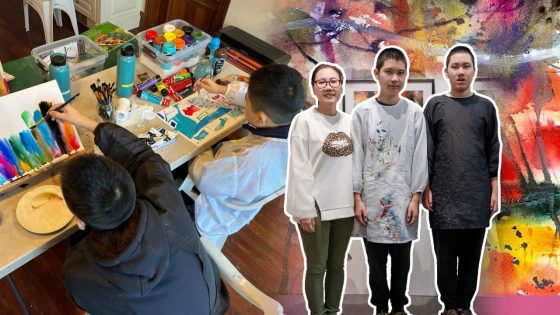Key Points
- Lei Wang’s two sons are among 205,000 Australians living with autism.
- Data shows the unemployment rate for people with autism is more than three times the rate for people with other disabilities.
- Wang is helping her boys to prepare for a self-supporting future including through the medium of art.
Being a full-time single mother, Wang has spent most of her time taking care of her children since 2019, especially as Jason also has diabetes and epilepsy.
If I were not around one day, I would want my children to be able to support themselves.
Lei Wang
Both born in Australia, Jason Liu (R) and Jeno Liu (C), were diagnosed with autism at ages two and 10 respectively. Credit: Supplied
Employment obstacles for people with autism
“There are stereotypes about autism, what autism looks like, and what autistic people are capable of,” she told SBS Chinese.
Employers focus on the limitations of autistic people rather than our strengths.
Professor Sandra Thom-Jones

Professor Sandra Thom-Jones is an academic with autism and the author of “Growing in to Autism”. Credit: Supplied
Meanwhile, social skills expected in workplaces could be another obstacle for people on the spectrum, Thom-Jones added.
“There is often an expectation that for an autistic person to be accepted in the workplace, they have to communicate and act in ways that are consistent with non-autistic norms, but very unnatural for them,” she said.
Painting: a beacon of hope
To nurture her sons’ potential, Wang has enrolled them in a variety of courses such as piano, painting and violin.

Jason (L) and Jeno (R) have been taking private painting lessons for over two years. Credit: Supplied
Wang said their painting teacher had suggested she organise an exhibition of Jason’s work to explore its artistic value.
Earlier this month, Wang did just this with 76 paintings created by her sons on display in the Museum of Chinese Australian History in Melbourne.
A lot of people came and asked if the paintings were for sale and how much. I was surprised and felt proud.
Lei Wang
Thom-Jones said that her research showed that the wider public identified artists or musicians, supermarket shelf-stackers and computer programmers as the most common jobs that people with autism, “were expected to do”.

Jason and Jeno at their painting exhibition at the Museum of Chinese Australian History in Melbourne. Source: SBS / Supplied
However, she suggested that people needed to move beyond that stereotype to view autistic people in a wider range of careers.
“I know many autistic people who are employed across a vast range of careers including teaching, health care, retail, academia, law, creative industries and many others,” she said.
Many autistic people excel in these roles, due to their attention to detail, hyperfocus, pattern recognition and other known strengths of autism.
Professor Sandra Thom-Jones
‘Not a good fit’
However, Wang said she soon noticed that the class “wasn’t a good fit” for Jason.
He doesn’t speak much and English is very challenging for him because we stayed in China for a couple of years.
Lei Wang
“The class covered theoretical topics like photosynthesis and the structure of a flower. It was very challenging for my son to absorb, especially the English terms,” she said.

Jason attending horticulture training at a specialist school in Melbourne’s south-east. Credit: Supplied
Seeking alternative options, Wang said she had also explored day programs that offered services tailored to individuals with disabilities after they left school.
“It’s like a kindergarten and the cost is covered by NDIS … but my goal for (my) children to be self-supporting doesn’t work out there,” she said.

One of Jason’s paintings. Credit: Supplied
NDIS program
“But for some children with more severe conditions, they might not be eligible for this program.”

Lei Wang (C) migrated to Australia in 1999 and now lives in Melbourne with her two sons, Jeno (R) and Jason (L). Source: SBS / Shan Kou
shows that among 5,700 unique participants in 2022, 55 per cent have autism as their primary disability.
Further, only seven per cent of the total number were from culturally and linguistically diverse backgrounds.
National Autism Strategy
In addition, many autistic people found change distressing and challenging and transitions from school into employment could be extremely difficult, she added.
The ‘cliff’ is a well-recognised phenomenon where children finish school and are no longer eligible for many supports and services right when they need them the most.
Professor Sandra Thom-Jones
“I hope that all autistic people will find a career that they love, but for some of them, this may be a part-time or even unpaid role.”

Jason (centre) celebrates his 11th birthday with his mother and brother. Credit: Supplied
To help guide a national approach to support people with autism, the federal government is working on awhich will cover key reform areas including access to services, healthcare, education and employment.
The Strategy will be “a whole-of-life plan for all Autistic Australians – not just those eligible for the National Disability Insurance Scheme,” a Department of Social Services spokesperson told SBS Chinese.
The discussion paper highlights that greater awareness and acceptance of Autism is needed in the community.
Department of Social Services spokesperson
The draft is expected to be released for public comment shortly.
Source Agencies



